Album Weeds – Chile



 1854-67. 1, 5, 10 and 20 Centavos.
1854-67. 1, 5, 10 and 20 Centavos.
Genuine
Engraved, in taille-douce, on wove paper, generally rather rough; watermarked with the value in numerals. They are all from the same die, so that the description of one will answer for all the rest. The ink stands out well from the surface of the paper. The ground of the central circle is formed by a multitude of engine – turned lines, very close together; and there are a great many very tiny, triangular white spots, between the intersections of the engine-turning, but these spots are quite invisible at a little distance, being not at all prominent. In each of the top corners of the stamp, there are two little ovals, or rather links of a chain, and just below them, also in each corner, there are four similar links or ovals; but the first 0 of CORREOS cuts into the lowest link of the four on the left side of the stamp, and the O of FRANCO cuts into the lowest of the four on the right side. The O of PORTE looks rather taller than the rest of the letters of that word. The F of FRANCO is too thin, and the R is too thick. There is a slightly scalloped line of white, running all round, immediately inside the outline of the central circle; but it is so very faint, that it would not be noticed, unless purposely looked for. There is a very great variety in the printing of these stamps; the earlier ones are beautifully executed, but the later ones are often very much smudged, so that the details of the design can hardly be seen. The first-issued 5 centavos was printed on very strongly bleute paper. The forgers have not ventured to imitate this; at least, I have never seen a copy.
Forged
Lithographed, on thin, hard paper; no watermark. The ink does not stand out from the surface of the paper. The ground of the central circle is formed by a sort of very coarse network of colour; the spaces between the network being very large, mostly round or oval, and each space having two or three thin lines crossing it. This gives a very spotty look to the whole groundwork, and the white spots can be seen at a considerable distance, being the first thing to strike the eye, after the head and lettering. In the left top corner of the stamp, there are parts of three ovals or links, instead of two, and below them there are four more, like the genuine, only the lowest one does not go near the word CORREOS. In the right top corner, there are two links, and below them four more; the O of FRANCO going rather close to the lowest one, but not absolutely cutting into it. The O of PORTE is the same height as the rest of the word, and the F and R of FRANCO are of the same thickness as the other letters. Inside the outline of the central circle, there is a very prominent, scalloped line, running right round the circle, which is far more conspicuous than the corresponding line in the genuine stamps. In many copies, the first O of COLON is badly drawn, but I notice that this is not always the case, so that it is not much of a test. The easiest test is the spotty ground of the central circle, which condemns these counterfeits at a glance.
Postmarks
Genuine.—Most frequently shapeless blotches. Also 10, 75. An oval of straight lines, containing CANCELLED in large letters, is often to be met with. I conclude this was the postmark of the British Packet Agency.
Forged.—1, 10, 62. With regard to postmark No. 1, only a quarter of it is usually to be seen, so it was evidently printed at the intersection of four stamps on the sheet.




 1867. 1, 2, 5, 10 and 20 Centavos.
1867. 1, 2, 5, 10 and 20 Centavos.
Genuine
Beautifully engraved, in tattle-douce, on thick, hard white wove paper, no watermark, perforated 12. The white lines of the engine-turning of the central circle There is no dark line round the outline of the bust of Columbus. A line drawn along the profile of the bottom of the beard, from the point to where it joins the neck, would slope decidedly down- wards to the left. The bottoms of the letters ILE of CHILE just touch each other.
Forged
Very coarsely lithographed, on stout, white wove paper, no watermark, unperforated, or pin-pricked 13. The white lines of the imitation engine-turning in the central circle are all straight and oblique, instead of curved. There is a broad and very prominent line of shading all round the whole portrait, especially marked in front of the face. A line drawn along the profile of the bottom of the beard, from the point to where it joins the neck, would slope decidedly upwards to the left. The bottoms of the letters HILE are all firmly joined together. The whole impression is very poor and coarse, and immeasurably inferior to the genuine in every way. The broad line of shading, round the bust, is a very easy instant test. Some of the forgeries are to be found unperforated, as I have already said; the originals are always perforated. It will be noticed that I have not troubled to give many details of these last forgeries, for they are so very poor that it would be almost an insult to my readers to suppose them capable, for one instant, of being taken in by these miserable counterfeits.
Postmarks
Genuine.—Shapeless blotches seem to be the most usual cancellations, but 1 have seen 18, 29 (larger), and one rather like 3, but with one line across the center, instead of two. As to 18, if a cork were to have a plain cross, of about inch wide, cut out of its end, and were then used as a handstamp, it would accurately represent this cancellation.
Forged.—1, 62, 76.
Bogus Bisected Stamp
The 10 c. is not infrequently found, cut diagonally in half, each half to serve as a 5 c. I have seen specimens where a genuine stamp has been fraudulently bisected, stuck on a piece of paper, and the whole postmarked with 10, very carefully, so that half shows on the paper, and half on the stamp. To those who collect bisected stamps, I would suggest that they only take them on the entire envelope, so as to avoid, as far as possible, becoming victims to the arts of the forger.
From: ‘Album Weeds’, 3rd edition by R. B. Eareé. 1906
![]() See also –> Spud Papers – Chile
See also –> Spud Papers – Chile

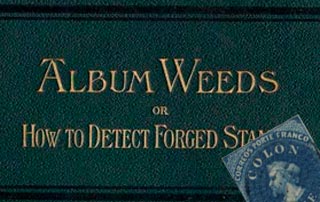
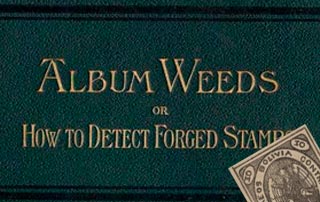

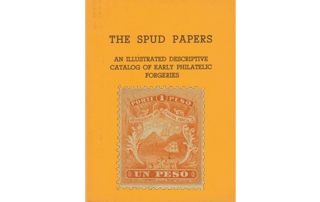
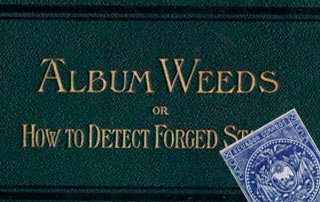
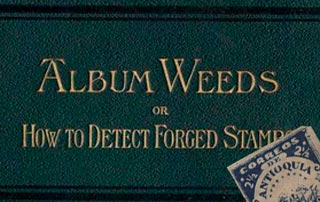
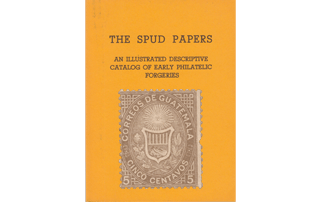
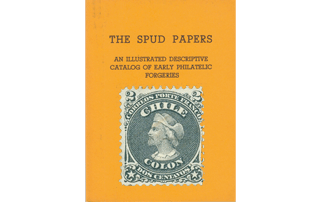
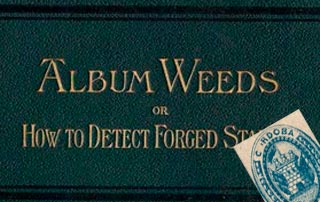
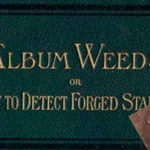
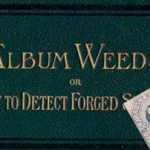
Leave a Reply
Want to join the discussion?Feel free to contribute!